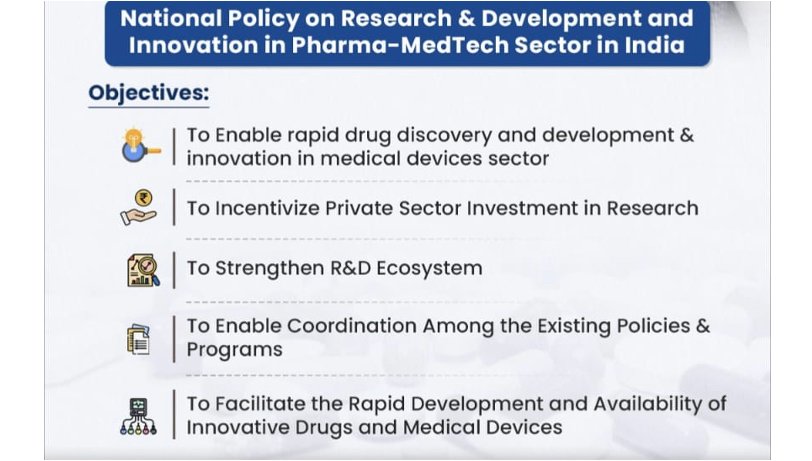Dr Manisha Verma is Additional Director General (Media), Ministry of Chemicals and Fertilisers, Government of India.
Government of India has recently launched the National Policy on Research and Development (R&D) and Innovation in Pharma-MedTech Sector and the Scheme for promotion of Research and Innovation in Pharma MedTech Sector (PRIP). Let us learn more about this Policy-what are its salient features and in what manner will it lead to strengthening the R&D in the pharma sector.
Indian Pharmaceutical sector
The Indian pharmaceutical industry is widely recognised as ‘Pharmacy of the World’. It is the 3rd largest pharmaceutical industry by volume with current market size of around USD 50 Billions. The industry could potentially grow to USD 120-130 Billion (₹ 9,84,000 to ₹ 10,66,000 crores) over the next decade, increasing its contribution to GDP by about 100 basis points.
India is one of the biggest global suppliers of low-cost vaccines. 60 % of global vaccines are produced in India. India is a global leader in supply of DPT, BCG and Measles vaccines. We contribute up to 70 % of the WHO demand for Diphtheria, Tetanus and Pertussis (DPT) and Bacillus Calmette–Guérin (BCG) vaccines, and 90% of WHO demand for the measles vaccine.
India is also the largest provider of generic medicines globally, occupying a 20% share in global supply by volume. The industry manufactures about 60,000 different generic brands across 60 therapeutic categories.
India exports Pharmaceuticals to over 200 countries. Over 50% of Africa’s requirement for generics, nearly 40% of generic demand in the US and approximately 25% of all medicine in the UK is supplied by India.
Additionally, we have the highest number of US-FDA compliant Pharma plants outside of USA. India is home to more than 3,000 pharma companies with a strong network of over 10,500 manufacturing facilities as well as a highly skilled resource pool.
Major segments of the Pharmaceutical Industry include generic drugs, bulk drugs, vaccines, Over-The-Counter (OTC) medicines, biosimilars and biologics. There are 500 Active Pharmaceutical Ingredient (API) manufacturers contributing about 8% in the global API Industry.
As per the FICCI Report on Indian pharma industry (2021), India’s pharma industry has demonstrated a compounded growth rate of (CAGR) of about 11% in the domestic market, while the exports have registered a 16% growth over the last two decades. The domestic market has grown at a pace similar to the gross domestic product (GDP); the overall growth is reportedly driven by the industry’s remarkable steps in supplying generic formulations to global markets.
India’s pharmaceutical sector is a major contributor to the country’s foreign trade and the trade surplus. During 2022-23, total pharmaceutical exports were pegged at USD 25.26 Bn.
Apart from this, the pharmaceutical sector is a favourite destination for foreign investors, and has emerged as one of the top ten attractive sectors for foreign investment in India. It accounts for about 3.3% of total Foreign Direct Investment (FDI) inflows in the country across various sectors.100% FDI in the pharmaceutical sector is allowed under the automatic route for greenfield pharmaceuticals. Wherein 74% is allowed under the automatic route and thereafter through the government approval route.
Importance of R&D, and Innovation in pharmaceuticals
The global pharma sector has grown by leaps and bounds in the past decade. A significant role is played by enhanced research and innovation. Cutting edge insights and innovations in various clinical and non-clinical aspects have driven the worldwide growth. Sustainable and continued research is found to be important to fulfil growing and unmet needs and add value to the pharma sector.
The speed of innovations in the post-COVID era is observed to be much faster, and covers various un-chartered arena. ‘Big data and analytics’ are poised to play a big role, while technology is seen to drive the newer advancements in the sector. Machine learning, AI-powered drugs discovery, personalised medicines along with digital personal connect with patients, gadget driven treatment regimes, larger role of medical devices, nano drug driven clinical solutions are predicted to provide a competitive edge to manufacturers and drive massive outcomes. Drug re-purposing is another innovation that will underpin a shift in the pharmaceutical market. Re-purposed drugs were seen during COVID times too.
In addition to this, innovative thinking to encourage private investments, and to explore newer funding avenues for high risk / long term projects have often been discussed. Augmenting industry-academia collaboration and to establish a strong research and innovation ecosystem, developing innovative models for improving drug affordability as an alternative to price capping, upgrading the manufacturing facilities and supply chain infrastructure with technology, automation and digital interventions to improve efficiencies have also been flagged as critical pillars to provide impetus for a strong growth in the sector.
Prime Minister Shri Narendra Modi stated that India’s pharma industry is an “asset for the entire world” (July 2020). He further highlighted that “vaccines made in India are responsible for two-thirds of the vaccine needs of the world’s children”. He has acknowledged the importance of research and innovation as critical components for New India. In his speech from the ramparts of Red Fort on India’s 76th Independence Day, he said- “Now, there is another necessity to add, Jai Anusandhan (research and innovation). Jai Jawan, Jai Kisan, Jai Vigyaanaur Jai Anusandhan.”
There is immense ground to be covered by India in R&D in various sectors. NITI Aayog has flagged India’s lagging position vis-à-vis other countries in this regard. With an eye on the ample opportunities that can be explored and captured, the Parliament recently approved the Anusandhan National Research Foundation (NRF) Bill, 2023, which provides for establishing the Anusandhan National Research Foundation (NRF).
NRF will be the apex national body to provide strategic direction for research, innovation, and entrepreneurship in the fields of: (i) natural sciences including mathematics, (ii) engineering and technology, (iii) environmental and earth sciences, (iv) health and agriculture, and (v) scientific and technological interfaces of humanities and social sciences.
Recognising the importance of and need for research and innovation in the pharma sector, and based on recommendations of the Parliamentary Standing Committee in its 46th Report, Department of Pharmaceuticals, Government of India constituted a high level inter- departmental committee to draft and finalize Policy on R&D and Innovation in pharmaceuticals & medical devices sectors. It submitted its report in September, 2020.Based on the suggestions, the ‘Policy to Catalyse R&D and Innovation in the Pharma MedTech Sector in India’ has been prepared to encourage R&D in pharmaceuticals and medical devices and to create an ecosystem for innovation in the sector in order for India to become leader in drug discovery and innovative medical devices through incubating an entrepreneurial environment. The Policy has been notified in gazette on 18th August, 2023.
The Policy focus is on three areas:
1. To create a regulatory environment that facilitates innovation and research in product development, expanding the traditional regulatory objectives of safety and quality.
2. To incentivize private and public investment in innovation through a mix of fiscal and non-fiscal measures.
3. To build an enabling ecosystem designed to support innovation and cross-sectoral research as a strong institutional foundation for sustainable growth in the sector.

Furthermore, in order to facilitate and promote collaboration among industry, academia and research institutions across departments, and to promote domestic and international collaboration in R&D in Pharma Med-tech sectors, an Indian Council of Pharmaceuticals and Med-tech Research and Development is proposed to be set up.

Implementation of provisions of the Policy is expected to result in increased drug security and availability; improvement of overall healthcare index and reduced disease burden; higher contribution in the GDP; increased exports and forex inflow; increase in global market share; creation of high-end jobs in R&D and Innovation and opportunity to attract Indian talent with expertise in R&D and Innovation.

PRIP (Promotion of Research and Innovation in Pharma MedTech Sector)
At present a major component of Indian exports are low value generic drugs while a large proportion of the demand for patented drugs is met through imports. This is because the Indian Pharmaceutical sector still has much ground to cover in high value production and instil global pharma R&D. In order to incentivize the global and domestic players to enhance investment and production in these product categories, a well-designed and suitably targeted intervention is required to give impetus to specific high value goods such as biopharmaceuticals, complex generic drugs, patented drugs or drugs nearing patent expiry, cell based or gene therapy drugs. The medical device sector also forms an essential and integral constituent of the healthcare sector, and any innovation in pharma sector needs to cover this category too.
In view of the above, Department of Pharmaceutical has recently unveiled the PRIP (Promotion of Research and Innovation in Pharma MedTech Sector) scheme with a budget outlay of Rs. 5000 crores. It was notified in the Gazette on 17th August 2023. The objective of the scheme is to transform Indian pharmaceuticals sector from cost-based to innovation-based growth by strengthening the research infrastructure in the country. The scheme aims to promote industry-academia linkage for R&D in priority areas and to inculcate the culture of quality research and nurture the pool of scientists. This is expected to lead to sustained global competitive advantage and contribute to quality employment generation in the country.
The scheme has two components-
1. Strengthening the research infrastructure by establishment of seven Centers of Excellence (CoE) at National Institute of Pharmaceutical Education and Research (NIPER). These CoEs would be set up in pre identified areas with a financial outlay of Rs. 700 Crores.
2. Promoting research in pharmaceutical sector by encouraging research in six priority areas like new chemical entities, complex generics including biosimilars, medical devices, stem cell therapy, orphan drugs, anti-microbial resistance etc., wherein financial assistance will be provided for the industries, MSME, SME, startups working with government institutes and for both in- house and academic research. The component has a financial outlay of Rs.4,250 Crores.
The following benefits are being envisaged-
1.Development of research infrastructure- The scheme would help in building a world class research atmosphere at NIPERs and other institutes and help in creating talent pool of qualified trained students.
2.This scheme will promote industry-academia linkages by promoting collaboration between private sector and government institutes.
3.Focus on certain priority areas which will help India’s pharma industry leapfrog and radically strengthen its position in the world market as innovation accounts for 2/3rd of global pharmaceutical opportunities.
4.The scheme would help in launching of commercially viable products which will accelerate the growth of Indian pharmaceutical sector by increased revenue and creating employment opportunities.
5.The scheme would help in the development of affordable, accessible solution for primary area of health concern thus reducing health care burden.


